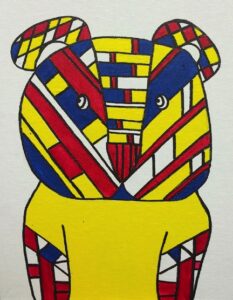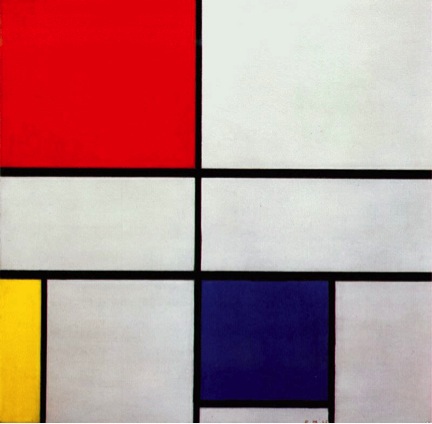Lesson: Mondrian Animals
Combining the distinct painting style of Dutch painter Piet Mondrian with the fun challenge of drawing animals, Mondrian Animals are a fun way to explore and practice drawing, painting, art history, and color theory.
Goals
- Learn about Art History while applying concepts learned into an original piece of artwork.
- Increase knowledge of a famous painter in Art History.
- Adopt a style of artwork while learning about color theory and painting techniques.
Materials
- Canvas Board
- Pencil
- Sharpie – Black
- Ruler
- Acrylic Paints – Primary Colors
- Paintbrushes
- Water
Steps
- Choose an animal to draw. The animal can be drawn as a whole, or just a part of the animal.
- Sketch the animal on to the canvas board with a pencil. Make the animal large, filling up as much of the canvas as possible.
- Look at examples of Piet Mondrian’s artwork.
- Use a ruler to separate the animal into rectangular sections using the black Sharpie.
- Paint the sections using primary colors, (red, yellow, and blue) leaving some areas white.
- Dry.
Tweak It!
- Younger students can create the project with watercolor paint or tempera paint on watercolor paper or mixed media paper.
Ten facts about Piet Mondrian, the Dutch painter:
- Piet Mondrian was born on 7th March 1872 in Amersfoort, the Netherlands.
- From a very young age, Piet Mondrian was exposed to art. His father was a qualified art instructor and his uncle was an artist.
- Piet Mondrian became a primary school teacher and he painted in his spare time.
- His early paintings were mainly landscapes, featuring fields, rivers and windmills.
- Mondrian moved to Paris in 1911. He was immediately influenced by the Cubist style of Picasso and Braque, and his work started to incorporate more geometric shapes, moving away from being purely naturalistic.
- Piet Mondrian returned to the Netherlands for the duration of the First World War. He met the artist Bart van der Leck, who only used primary colors in his paintings. Mondrian started to develop his own painting theory and style.
- After WW1, Mondrian returned to Paris and he began to produce the grid-based abstract paintings for which he is best known.
- Mondrian left Paris in 1938 to escape the inevitable advance of the Nazis. He moved to London and then to Manhattan.
- In Manhattan, Mondrian started to develop anew technique using pieces of paper tape to create small rectangles of color.
- Piet Mondrian died on 1st February 1944. He had pneumonia.
http://primaryfacts.com/812/10-piet-mondrian-facts/
Examples of Mondrian’s work:
Composition No. II (1920) by Piet Mondrian – www.piet-mondrian.org
Composition C (1935) by Piet Mondrian – www.piet-mondrian.org
© Arts For Life 2015


